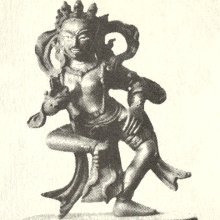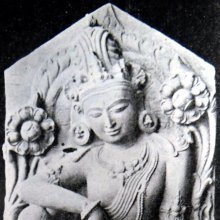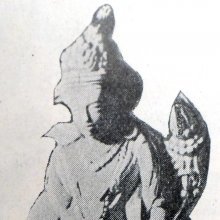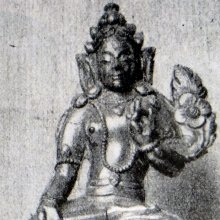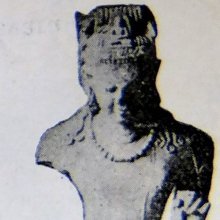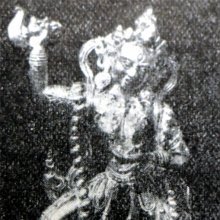Vajraghanta, Vajra-ghanta, Vajraghaṇṭā, Vajraghaṇṭa: 2 definitions
Introduction:
Vajraghanta means something in Buddhism, Pali. If you want to know the exact meaning, history, etymology or English translation of this term then check out the descriptions on this page. Add your comment or reference to a book if you want to contribute to this summary article.
Images (photo gallery)
(+5 more images available)
In Buddhism
Tibetan Buddhism (Vajrayana or tantric Buddhism)
Source: archive.org: The Indian Buddhist Iconography1) Vajraghaṇṭā (वज्रघण्टा) refers to one of the ten Goddesses of the Vajratārāmaṇḍala belonging to Vajratārā: one of the various emanations of Ratnasambhava, as mentioned in the 5th-century Sādhanamālā (a collection of sādhana texts that contain detailed instructions for rituals).—Accordingly, the sādhana further says that the Guardians of the Gates should also be meditated upon as around the principal Goddess, but apparently not in the same circle with the [four cardinal Goddess]:—“On the northern gate there is Vajraghaṇṭā of white colour. She has one distorted face. In her two hands she carries the bell marked with a vajra”.
All these Goddesses [viz., Vajraghaṇṭā] stand on the orb of the sun in the ālīḍha attitude with the right leg stretched forward. They are radiant like the Sun-god and are surrounded with a fiery halo. They are decked in ornaments of snakes. [...] These Goddesses originate from the ten different letters of the mantra of Vajratārā, which is “oṃ tāre tuttāre ture svāhā”, consisting of ten syllables. Each syllable brings forth a Goddess, and these Goddesses are said to be the embodiments of the ten paramitas of the Mahāyāna School.
2) Vajraghaṇṭā (वज्रघण्टा) presides over the North and represents one of the six Goddesses of the directions, commonly depicted in Buddhist Iconography, and mentioned in the 11th-century Niṣpannayogāvalī of Mahāpaṇḍita Abhayākara.—Her Colour is green; her Symbol is the bell; she has one face and two arms.—The fourth deity in the series is Vajraghaṇṭā, who is the embodiment of the Northern direction.
Vajraghaṇṭā is described in Niṣpannayogāvalī (vajratārāmaṇḍala) and Sādhanamālā (vajratārāsādhana) as follows:—
Source: OSU Press: Cakrasamvara Samadhi“In the North there is Vajraghaṇṭā, green in colour, holding in her right hand the Bell”.
[The left hand of the goddess displays as usual the raised index finger.]
Vajraghaṇṭā (वज्रघण्टा) refers to “(holding) a vajra-bell” and is used to describe Śrī Vajrasattva, according to the Guru Mandala Worship (maṇḍalārcana) ritual often performed in combination with the Cakrasaṃvara Samādhi, which refers to the primary pūjā and sādhanā practice of Newah Mahāyāna-Vajrayāna Buddhists in Nepal.—Accordingly, “Oṃ in the middle of mantra inhabited ground, arisen of the four seeds, yaṃ, etc., a maṇḍala of the great elements, wind, fire, water, and earth, Above that, (arising from) the letter suṃ, is the merumaṇḍala, Above that, on a jeweled lion-throne, lotus, and a lunar-disc, Śrī Vajrasattva, two arms, one face, white color, Holding a vajra (and) vajra-bell (vajraghaṇṭā-dhara), (and) adorned wearing various colors, Bearing a monk’s headdress, (and) a sapphire Akṣobhya adorned crown, Thus imagine the worshipful guru[...]”.

Tibetan Buddhism includes schools such as Nyingma, Kadampa, Kagyu and Gelug. Their primary canon of literature is divided in two broad categories: The Kangyur, which consists of Buddha’s words, and the Tengyur, which includes commentaries from various sources. Esotericism and tantra techniques (vajrayāna) are collected indepently.
See also (Relevant definitions)
Partial matches: Vajra, Ghanta.
Starts with: Vajraghantadhara.
Full-text: Hastapuja, Cakrasamvarasamadhi, Vajraghantadhara, Simhasya, Vajrataramandala, Ashtabhujakurukulla.
Relevant text
Search found 7 books and stories containing Vajraghanta, Vajra-ghanta, Vajraghaṇṭā, Vajraghaṇṭa, Vajra-ghaṇṭā, Vajra-ghaṇṭa; (plurals include: Vajraghantas, ghantas, Vajraghaṇṭās, Vajraghaṇṭas, ghaṇṭās, ghaṇṭas). You can also click to the full overview containing English textual excerpts. Below are direct links for the most relevant articles:
The Indian Buddhist Iconography (by Benoytosh Bhattachacharyya)
Figure 105-108 - (Avalokiteśvara): Lokanātha
Figure 180-183 - Emanations of Ratnasambhava: Vajratārā and Puṣpatārā
Lakulisha-Pashupata (Philosophy and Practice) (by Geetika Kaw Kher)
A brief insight in Vajrayana Buddhism < [Chapter 2 - Spread and Transition]
Blue Annals (deb-ther sngon-po) (by George N. Roerich)
Chapter 5 - Cakrasaṃvara < [Book 7 - The preaching of the Tantras]
Chapter 6 - First incarnation series (vi): rang byung rdo rje (Karmapa III) < [Book 8 - The famous Dakpo Kagyü (traditions)]
Chapter 28 - Paṇḍita Vanaratna < [Book 10 - The Kālacakra]
Stupas in Orissa (Study) (by Meenakshi Chauley)
Minor Votive Stupas at Ratnagiri < [Chapter 4]
Puranic encyclopaedia (by Vettam Mani)
The gods of northern Buddhism (by Alice Getty)
